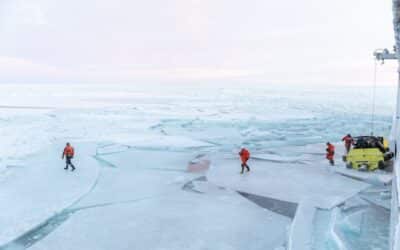A government-sponsored scientific panel called for more research on geoengineering — here’s why we shouldn’t even consider it
by Shannon Hall (ScienceLine)
Geoengineering — that wild and grandiose idea that suggests we could offset and even reverse the alarming effects of global warming — has been viewed as an insane notion for decades. Surely we’d have to be truly desperate before we’d even consider deliberately fiddling with the planet on such a massive scale.
But now, some experts think we’ve reached the point where we have no choice but to look into geoengineering.
Earlier this year, the National Research Council released two reports that called for more research on the idea. The first report examined ways we could remove some of the carbon dioxide from the atmosphere. At first glance, this might be plausible. But the second report looked at far more controversial methods, such as releasing reflective particles into the atmosphere to block sunlight and therefore cool the Earth.
The second report warned that at this time, these methods were risky and poorly understood. But I’d like to take this a step further: Both reports contain ideas that will never be practical and are actually more dangerous than the problem at hand. We will never understand the risks well enough to justify any of the outlandish schemes that these reports describe.
Most scientists agree that geoengineering should never be a substitute for solving the problem upfront. Sadly, we’ve been so slow to burn fewer fossil fuels and cut our greenhouse gas emissions that many scientists now think geoengineering might help us clean up the mess we’ve already made.
As human beings, we have the tendency to think that technology will save us. But if there’s one lesson we should have learned by now, it’s that we can’t keep playing God with the planet. We simply don’t understand the climate system well enough to predict how any geoengineering method would play out in the future.
Although the first report, on carbon dioxide removal, doesn’t seem completely ludicrous at first glance, it takes just one example to reveal its folly. In 2012, a rogue American millionaire dumped 220,000 pounds of iron sulfate into the Pacific Ocean to create a massive, carbon-sucking plankton bloom, nearly 4,000 square miles big. This illegal maneuver may have removed some carbon dioxide from the atmosphere, but scientists worry these blooms can kill marine life and cause toxic tides.
The second report examined a much easier and cheaper approach than removing atmospheric carbon: Spraying reflective particles, called aerosols, into the atmosphere, to intercept incoming solar radiation. This would essentially be the man-made equivalent to volcanic eruptions. WhenMount Pinatubo erupted in 1991, spraying white ash more than 12 miles high, it temporarily lowered the Earth’s temperature by nearly 0.3 degrees for three years. But this method, too, has scary side effects.
Every cloud droplet forms around an aerosol particle. But man-made aerosols differ in size, composition and number from natural aerosols. So they could form radically different clouds.
Scientists aren’t sure how well these man-made clouds would reflect sunlight back into space (therefore reducing the Earth’s temperature). They might be tenuous enough to let more light through. They would also likely affect the raindrops forming within the clouds, creating huge precipitation changes that could bring droughts to some areas and floods to others.
But what’s really scary about geoengineering is that once we start, we can’t really stop. As soon as we quit sucking up carbon dioxide or spraying aerosols into the atmosphere, the Earth will heat up rapidly. And a rapid heat increase is much more dangerous than one spanning a century or more. The world’s ecosystem, not to mention the humans within it, will have little time to react.
So the million-dollar question is: Is geoengineering, despite its obvious drawbacks, still worth investigating — just in case? No. The longer we look into it, no matter how innocently, the more likely we are to do it. We’ll gain some understanding of the climate system and think we know it all. But we will never know every foreseeable side effect.
It’s time to put our resources into harvesting green energy today. Researching geoengineering will only take attention away from the problem at hand. It risks that we’ll continue to burn fossil fuels under the assumption that we’ll fix the issue later. And that’s a chance we simply cannot take.
One thing is certain: The fact that some serious scientists are now calling for more research on geoengineering means we’ve reached a terrifying place. Isn’t it time to finally get serious about cutting carbon emissions instead of holding out for techno-fixes that could backfire disastrously?




